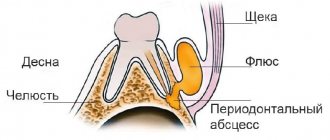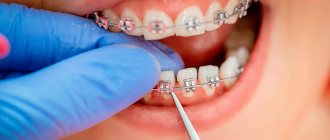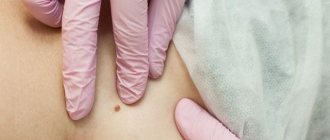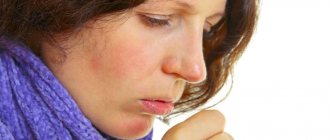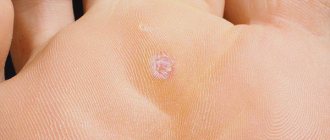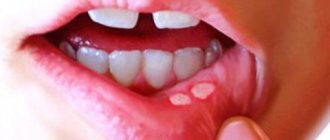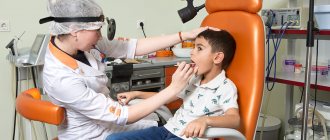Genital warts in the mouth appear as a result of infection with the human papillomavirus.
They can reach large sizes and cause complications and malignant tumors.
Patients with condylomas are shown not only their removal, but also antiviral treatment to reduce the risk of cancer and prevent the recurrence of these formations.
Why do condylomas occur in the mouth?
The causative agent of condylomas is HPV (papillomavirus).
It is transmitted by contact.
It is most often spread through sexual contact.
Therefore, most warts appear in the anogenital area and oral cavity.
The incubation period after infection lasts from 1 to 9 months.
Most often, infection with HPV types 6 or 11 leads to the appearance of condylomas.
At the same time, the sixth type of virus is more often detected in patients with warts in the genital area.
Damage to the oral cavity, larynx and pharynx is more typical for the eleventh type of HPV.
On the other hand, there are internal reasons for the development of infection.
Many people become infected with HPV during their lifetime.
However, not everyone gets warts.
For many, the persistence of the virus is asymptomatic.
Within 1-2 years, the body simply gets rid of HPV, and the person does not even know that the virus was present in the body.
But a certain group of patients develop condylomas in the mouth, and some even develop malignant oncological processes.
They are most often provoked by HPV type 16.
Risk factors for the appearance of warts in case of infection with papillomavirus:
- smoking
- HIV infection
- diabetes
- physiological immunosuppression during pregnancy
- taking drugs that suppress the immune system (cytostatics, glucocorticoids)
Routes of transmission of genital papillomas
As already mentioned, the main type of transmission of human papillomavirus infection is sexual, and therefore it belongs to the group of STIs. This means all types of sexual intercourse not protected by a condom, including oral and anal.
But in addition to sexual transmission, there are other, less common, but no less dangerous ways of transmitting HPV of the type that causes the appearance of genital warts:
- during the passage of the fetus through the birth canal of an infected mother;
- in a household way - through things belonging to an infected person: towels, washcloths, combs, underwear and outerwear;
- self-infection when scratching tumors, when shaving with the spread of the virus and the formation of new lesions;
- when visiting public swimming pools, saunas, baths, gyms, since HPV persists for a long time in a humid environment.
The virus does not penetrate the blood and therefore does not spread throughout the body, and the localization of papillomas when activated has a single or focal character with the merging of single neoplasms. In the latter case, entire colonies of genital warts form in the anogenital area, which are easily injured during sexual intercourse.
Condylomas in the mouth and tumors of the head and neck
Malignant tumors of the head and neck account for 1.5-2% in the structure of oncological pathology in different countries.
Of these, 90% are squamous cell carcinoma.
This is a very dangerous group of diseases that are diagnosed late.
In Russia, in two out of three patients, these tumors are detected at stages 3 or 4.
Only a third of cases occur in stages 1-2, which, as a rule, can be successfully treated.
Recently, there has been an increase in incidence.
This is largely due to changes in sexual culture.
Papillomavirus remains one of the main risk factors for head and neck tumors.
Most neoplasms are caused by high-oncogenic risk HPV: type 16 or 18.
In different countries, the share of HPV-associated head and neck tumors in the overall structure of this group of pathologies ranges from 20% to 90%, depending on the prevalence of smoking.
This bad habit is the second most important risk factor for malignant tumors of the corresponding localization.
Thus, in Sweden, due to a significant decrease in the number of smokers over the past 40 years, the proportion of HPV-associated squamous cell oropharyngeal cancer has increased from 31% to 95%.
Currently, it is considered as a separate nosological entity.
Because the clinical course of such tumors has its own characteristics.
They are as follows:
- the primary tumor is usually small in size
- Regional metastases appear early
- neoplasms are highly sensitive to radiation and chemotherapy
- the most common localization is the tonsils and the root of the tongue
- type of cancer – non-keratinizing
- more often diagnosed at a young age
- Patient survival rate is higher
Is it possible to remove condylomas with celandine?
Celandine juice contains substances that can destroy tissues affected by the papilloma virus. In principle, this traditional method of treatment works, but it is low in effectiveness (it will take several days to remove the wart) and is useless for large, numerous condylomas. Modern medicine offers more effective treatment methods, one of them is radio wave surgery.
What happens after removal of condylomas using radio waves?
A small wound remains at the site of the intervention. As a rule, it heals completely within 5–7 days, and new pink skin appears in its place.
How to properly care for the wound after surgery?
After removing condyloma using radio wave surgery, potassium permanganate and other aggressive agents should not be used, and the wound should not be allowed to dry out and form a crust on it: the best cosmetic effect is achieved with moist healing.
What can and should be done:
- In the first days, carefully monitor the condition of the wound.
- Treat it with warm soapy water.
- Take a bath and shower.
- Drink enough fluids.
- Consult a doctor immediately if pain begins to bother you, lumps appear, or skin color changes.
What not to do:
- Tear off the crust if it still appears. This can cause a noticeable scar to form.
- Apply cosmetics to the wound.
- Visit swimming pools, baths and saunas until the wound has healed completely.
- Keep the wound in the sun and visit solariums.
- Press on the wound, injure it.
You will receive more detailed recommendations from your doctor at the clinic. Feel free to ask questions.
Is additional treatment necessary after genital wart removal?
Genital warts are a viral disease, so removing them alone is not enough. If the virus remains in the body, it can cause a relapse. The risks increase if you have a weakened immune system, have chronic diseases, or if you often change sexual partners. In order to cope with the pathogen, the doctor will prescribe antiviral drugs and agents that strengthen the immune system.
Is it possible to remove condylomas during pregnancy?
Pregnancy and breastfeeding are contraindications to the use of radio wave surgery. It is better to get rid of genital warts at the planning stage. Other contraindications to the use of the Surgitron device: severe diseases of the heart, lungs and other organs, acute infections, the presence of a pacemaker, exacerbations of chronic diseases, epilepsy, cancer, infectious and inflammatory processes on the skin. If a woman is having her period, she will have to wait until it ends.
To find out if there are any contraindications in your case, visit a doctor at the ProfMedLab clinic.
How can one reliably diagnose human papillomavirus infection in genital warts?
Genital condyloma is easily recognized during an external examination by any dermatovenerologist. The doctor may order additional tests:
- A Papanicolaou smear (PAP test) helps detect abnormal cells.
- PCR detects the genetic material of the pathogen in smears and scrapings.
- The Digene test helps detect high cancer risk viruses and assess the risk of a malignant tumor.
Removal of genital warts using radio waves using the Surgitron device is a quick, low-traumatic and painless procedure. You can take it at the ProfMedLab clinic. To make an appointment with a doctor, call: +7 (495) 120-08-07.
What tests should I take for condylomas in the mouth?
Patients with condylomas in the mouth should be examined before treatment.
The very fact of the presence of these formations in the mouth is not difficult to establish clinically.
An experienced doctor in most cases can distinguish condylomas from other formations.
Although in doubtful cases, he may refer the patient for a blood test for antibodies to syphilis.
Because formations caused by HPV often resemble condylomas lata, which form in the secondary period of syphilitic infection.
However, the main goal of diagnosis is to determine cancer risk.
It is important to identify the HPV type.
In total, there are about 40 types that affect human skin and mucous membranes.
The most dangerous in prognostic terms is type 16.
It most often causes HPV-associated cancer.
It has been established that when HPV type 16 is detected in the human body, the risk of oropharyngeal cancer increases 14 times compared to HPV-negative patients.
In addition, the expression of oncogenic proteins E6 and E7 increases the risk of cancer by 73 times.
They can be detected during a serological blood test.
It detects antibodies to E6 and E7.
Thus, the following tests are used in the diagnosis of condylomas:
- PCR – allows you to determine the type of HPV, assess the oncogenic risk, and establish the viral load
- blood test for antibodies to proteins E6 and E7 - performed in case of detection of oncogenic types of HPV
- immunogram - assessment of the state of immunity is necessary in case of detection of oncogenic types of HPV, as well as in severe cases of human papillomavirus infection
Some patients develop too many warts in their mouth.
They are constantly increasing in size.
They often merge, reaching very impressive volumes.
Ulceration, infection, and a tendency to infiltrative growth are possible.
Such situations often indicate a decrease in immunity.
Therefore, they require an immunogram.
If an immune system deficiency is confirmed, additional tests may be performed to determine the cause of the condition.
A blood test is performed for antibodies to HIV.
If diabetes is suspected, the level of glucose in the blood is assessed, and if questionable results are obtained, a glucose tolerance test and a blood test for glycated hemoglobin are performed.
Laryngeal papilloma. Symptoms
Symptomatically, laryngeal papillomatosis can be represented by hoarseness, chronic cough, difficulty breathing, difficulty swallowing, recurring respiratory infections, and growth retardation in children. The presence of certain symptoms depends on the location of the papillomas. In children, the symptoms are more pronounced, since they have a significantly faster growth of papillomas, unlike adults. This can lead to situations in which emergency intervention is required for life-saving reasons, despite the histologically benign course of the disease. The prognosis is more favorable in terms of remission if the disease manifests itself in adulthood. The exception is the presence of HPV type 11 and the duration of the disease for more than 10 years.
Is a biopsy necessary for condylomas in the mouth?
A biopsy is performed to differentiate between benign and malignant tumors.
In addition, even if it is known for sure that the tumor is malignant, a biopsy is still done to establish its histological type.
Because different tumor structures require different therapeutic tactics.
If cancer of any location is suspected, a fine-needle biopsy is usually performed.
A section of tissue is taken for analysis using a needle or forceps, depending on the location of the tumor.
But if condylomas are present in the mouth, such a biopsy is usually not done.
Instead, an excisional biopsy is performed.
The formation is completely removed.
After this, it is sent for histological examination.
If examination of the sample shows that it is indeed condyloma, and there are no signs of malignancy, the patient is monitored.
It is carried out as long as high-oncogenic HPV remains in the body and there is a threat of oropharyngeal cancer.
If signs of malignancy are detected, the scope of the operation is expanded.
The patient is shown additional imaging tests (CT, MRI) to identify possible cancer metastases to the nearest lymph nodes and neighboring organs.
Symptoms and diagnosis
It is not easy to detect laryngeal papilloma on your own. They can be located either quite deep, or be microscopic and merge with the mucous membrane. Dysfunction of the swallowing function or problems with the vocal cords become the reason for contacting a doctor. The voice of people with education becomes hoarse and quiet. In addition, respiratory dysfunction may be present. And the younger the patient, the more clearly this symptom manifests itself.
When a patient seeks help, he is prescribed to undergo a laboratory test and a laryngoscopy procedure. The procedure involves inserting a special device into the throat, which allows you to increase visualization and examine the tumor in detail. Tests are necessary to confirm or deny the presence of the virus in the body. More often, ELISA (enzyme-linked immunosorbent assay) and PCR (polymerase chain reaction) help detect infection. The first finds antibodies produced by the immune system in the presence of infection. The second detects the DNA of the virus itself.
If necessary, the attending physician prescribes additional tests:
- endofibrolaryngoscopy with additional biopsy;
- histological examination of biomaterial;
- visual radiography;
- computed tomography;
- autofluorescence study.
Only with a fully conducted diagnostic study can one obtain the necessary information about the patient’s condition and prescribe the most effective treatment. And the sooner this happens, the more effective all measures taken will be.
Removal of warts in the mouth
In most people, condylomas are still benign formations that, although unpleasant, are not life-threatening.
If they appear, the chances that they will disappear on their own are not very high.
If this happens, it may take years for the condylomas to regress.
Therefore, it is better to spend half an hour or an hour of your time and remove the formations.
This procedure is completely painless and not dangerous.
It is worth removing condylomas while they are small.
In this case, the wound healing period will be shorter, the risk of complications or the formation of large scars is lower.
If the patient does not seek medical help, condylomas often grow.
In case of immunodeficiency, they can reach very impressive sizes, and serious, very traumatic operations are required to remove formations in the mouth.
In most patients, condylomas in the mouth are not large.
To remove them, our clinic uses all the basic techniques that exist today.
Among them:
- cryodestruction - destruction of formations with liquid nitrogen, indicated only for small formations (freezing large condylomas is fraught with severe inflammation and scarring)
- laser vaporization - condylomas are removed with a laser, this reduces the healing time of the wound, it is sterilized, there is no bleeding due to coagulation of blood vessels during the laser removal process
- electrocoagulation – electrical energy is used to remove formations; the advantage of the method is the ability to fully treat the entire pathological area, destroy viruses and have a low risk of relapse
- radio wave removal - allows you to get rid of condylomas in a non-contact way, by making the thinnest incisions with minimal risk of scarring (formations of any size can be removed)
If you need to remove condyloma in your mouth, contact our clinic.
After an examination, the doctor will choose the method of getting rid of these formations that is best suited based on size and location.
In some clinics, only 1-2 removal methods are available.
Therefore, doctors do not have the opportunity to choose the best one that suits a particular patient in a given situation.
We have all methods available at once.
Therefore, when choosing a doctor, he is guided not by the technical equipment of the clinic and the availability of techniques, but solely by clinical expediency.
The correct choice of removal method will allow you to:
- avoid relapse
- prevent complications and scarring
- provide the best aesthetic result
During the removal process, we use adequate pain relief.
Therefore, the procedure does not bring significant discomfort to the patient.
When to delete
Removal of condylomas is especially necessary in the following cases:
- growths interfere with the full functioning of the body;
- symptoms of the disease intensify;
- there is a suspicion of an oncological process;
- there is a threat to the patient's life.
The decision on the need for removal is made solely by the attending physician. You should not try to get rid of tumors on your own. This can lead to hazardous consequences for health and significantly complicate the existing situation.
Condylomas that occur inside the throat are a dangerous phenomenon that can significantly affect the patient’s quality of life.
Therefore, the sooner you visit a doctor, the fewer problems will arise in the future. The article has been verified by the editors
Recurrence of condylomas in the mouth
In order to prevent relapse (reappearance of formations), it is necessary not only to treat condylomas in the mouth, but also to get rid of the papilloma virus.
The higher the concentration of viral DNA in the oral mucosa, the greater the risk that the disease will return again.
As a result, the condylomas will have to be removed again.
In addition, in the presence of high-oncogenic risk HPV, the risk of oncological complications increases.
There is no doubt that the virus is worth getting rid of.
In our clinic, antiviral and immunomodulatory treatment is used for this purpose.
Immunity stimulation programs are most effective.
It is the activity of the immune system that determines:
- will HPV symptoms appear after infection (most people do not have them, although up to 90% of people who are sexually active come into contact with the virus)
- how large will the condylomas be?
- in what quantity will they appear in the mouth?
- how quickly the virus is eliminated (removed from the body)
- will there be complications, including cancer?
Immunity has the most significant influence on the clinical course of human papillomavirus infection.
Therefore, stimulation of the immune system makes it possible to influence the risk of complications and relapses.
A correctly selected treatment regimen in most cases allows you to get rid of not only the clinical manifestations of human papillomavirus infection, but also the carriage of HPV.
If there are pathological changes in the epithelium in the mouth (precancerous processes), they can regress after the virus is eliminated.
In our clinic, immunocorrection is carried out by an experienced immunologist.
It is selected individually, based on analyses.
Prevention of HPV infection (genital warts)
Treatment of condylomas is complex and lengthy. Therefore, it is much easier to prevent infection with the human papillomavirus than to then treat its consequences. To prevent the disease, you must first take care of safe sex. The risk group includes people with promiscuity. Therefore, the only way to protect your health is to have a relationship with one permanent partner.
A patient may be a carrier of the virus, but be completely unaware of it. For this reason, it is extremely important to use condoms during sexual intercourse. Vaccination of children against the most dangerous strains of the virus has also shown its effectiveness.
Pointed papillomas often occur against the background of suppressed immunity. Therefore, it is extremely important to lead an active and healthy lifestyle and eat well to strengthen the body’s immune functions. To strengthen the immune system, hardening, avoiding stress, getting adequate sleep, walking in the fresh air, and exercising are also recommended.
Is it possible to treat genital warts in the mouth without surgery?
There are two areas of non-surgical treatment of condylomas:
- local therapy aimed at eliminating the formations themselves
- systemic therapy aimed at correcting immunity and destroying viruses
Local therapy for the removal of condylomas in the mouth is not used in our clinic.
This is due to the fact that the drugs used to combat these formations are toxic to the body or cause burns.
When used in the oral cavity, ingestion is inevitable.
Methods that are used to remove condylomas of other locations:
- Cytotoxic treatment.
Over the course of several weeks, drugs that block cell division are applied to the condyloma.
But they are dangerous when taken orally.
In fact, according to the mechanism of action, these are the same drugs that are used for cancer chemotherapy.
- Chemical coagulation.
Substances containing alkalis or acids are used.
They cause tissue necrosis due to chemical burns.
But using such products in the mouth is very dangerous.
Because if you swallow or inhale such substances, you can get burns to the pharynx, esophagus, and larynx.
Sometimes immunocorrection allows you to get rid of condylomas without invasive methods.
But these formations do not always disappear and not immediately.
Therefore, it is better to simply remove them and undergo immunocorrective therapy to reduce the risk of relapse and cure the viral infection.
What consequences can condylomas lead to if they are not removed?
Condyloma is by no means a harmless neoplasm. The virus causes changes in cells that resemble those that occur in malignant tumors. Currently, the connection between human papillomavirus infection and cancer can be considered proven.
Genital warts often cause a host of other problems: they can become injured and bleed, ulcerate, and interfere with sexual intercourse and childbirth. In general, if growths in the form of warts are found in intimate places, it is better to immediately consult a doctor and have them removed.
